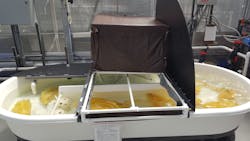Researchers at Pacific Northwest National Laboratory, working with engineers from LCW Supercritical Technologies, have extracted enough uranium to make five grams of yellowcake, a powdered form of uranium used to make fuel for nuclear power plants, using acrylic fibers to extract it from seawater.
“This is a significant milestone,” says Gary Gill, a PNNL researcher. “It indicates this approach can eventually provide commercially attractive nuclear fuel derived from the oceans, the largest source of uranium on Earth.”
The engineers at LCW developed the acrylic fiber which attracts and holds on to dissolved uranium naturally present in ocean water. It was made from an inexpensive yarn that was chemically modified into an adsorbent and selective for uranium, and efficient, and reusable. The yarn’s adsorbent properties are reversible, and captured uranium is easily released for processing into yellowcake. An analysis of the technology suggests that it could be competitive with the cost of uranium produced through land-based mining.
PNNL researchers have conducted three separate tests of the adsorbent’s performance to date, exposing it to large volumes of seawater from Sequim Bay next to its Marine Sciences Laboratory. The water was pumped into a tank about the size of a large hot tub.
Modified acrylic yards designed to capture uranium from seawater is tested at PNNL's Marine Sciences Laboratory.
For testing purposes, about two pounds of the fiber were put into a tank and seawater was quickly pumped through the yard to mimic conditions in the ocean. LCW then extracted the uranium from the adsorbent and, from these first tests, they got approximately five grams (about the mass of a nickel).
Seawater contains about three parts per billion of uranium, so it's estimated that there is at least four billion tons of uranium in seawater; this is about 500 times the amount of uranium known to exist in land-based ores, which must be mined.
Mining underground uranium has environmental challenges not encountered when extracting it from the oceans. And the fibers, which have affinity for other heavy metals besides uranium, could be used one day to clean up toxic waterways. The fibers could also extract vanadium from the oceans. It’s an expensive metal used in large-scale batteries.
For now, based on the successful scaled-up testing at PNNL, LCW is applying for more funding for a uranium extraction field demonstration; it would be led by PNNL in the Gulf of Mexico, where the water is much warmer. The yarn works much better in warmer water and extraction rates in the Gulf are expected to be three to five times higher, making it even more economical to obtain uranium from seawater.


